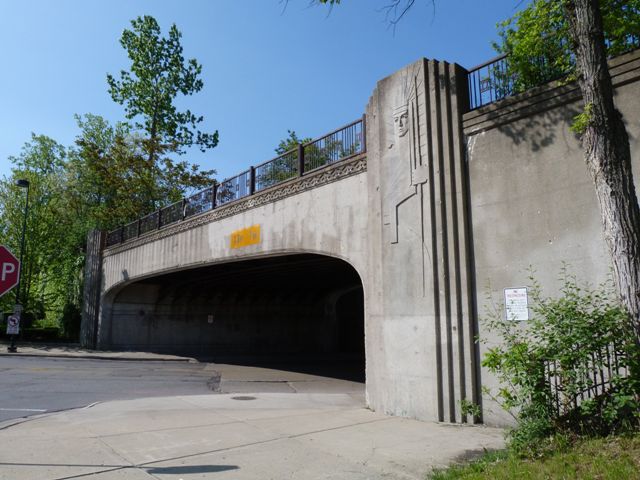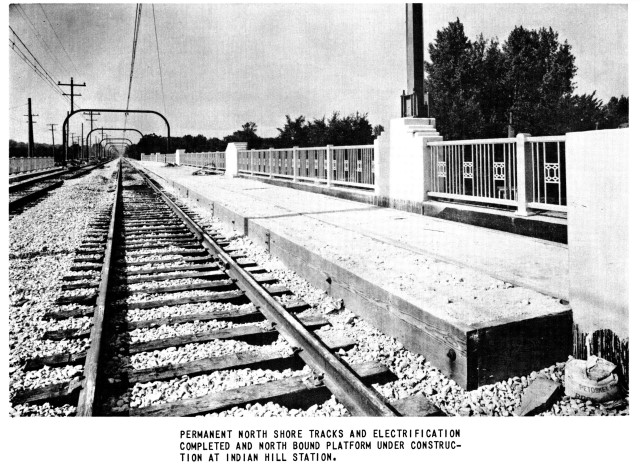We Recommend:
Bach Steel - Experts at historic truss bridge restoration.
BridgeHunter.com Phase 1 is released to the public! - Visit Now
Indian Hill Station Bridge
Winnetka Avenue Bridge

Primary Photographer(s): Nathan Holth
Bridge Documented: May 14, 2012
Railroad (Metra Union Pacific North Line and Green Bay Trail) Over Winnetka Avenue
Winnetka: Cook County, Illinois: United States
1940 By Builder/Contractor: Suburban Paving and Improvement Company of Chicago, Illinois
Not Available or Not Applicable
70.0 Feet (21.3 Meters)
73.2 Feet (22.3 Meters)
Not Available
1 Main Span(s)
16996113034

View Information About HSR Ratings
Bridge Documentation
This bridge is actually two independent parallel bridges that share a single abutment. The western bridge continues to carry the Metra North Line, while the eastern bridge has been converted to carry non-motorized traffic on a rail-trail system. These structures are unique among grade separation bridges because of their highly ornate architectural details. The highlight of these details include the bas-relief Indian head sculptures on the abutments, undoubtedly a nod to the fact that this area and the railroad station is known as Indian Hill. The bridge also features a concrete facing on the outside of the superstructure, which includes a detailed pattern cast into it, which hides the steel superstructure. The bridge also includes an ornate metal railing design. The bridge appears to be a steel rigid-frame type of bridge, since the built-up steel beams curve into the abutment, with the ends of the beams being encased in the concrete (rather than resting on bearings). North of the bridge, the railroad line maintains an elevated position, with concrete retaining walls that stylistically match the bridge being used. A short distance north of the bridge, there is a pedestrian tunnel, which is also detailed in an architecturally compatible manner, and was built as part of the same contraxt package.
The contract to build the bridge was let on September 7, 1939, so a ca. 1940 construction date is being listed here. The project was funded with assistance from Depression era relief programs, as the contract award is listed in a publication of the Federal Works Agency/Public Works Administration.
View Archived National Bridge Inventory Report - Has Additional Details and Evaluation
View Historical Article About This Bridge
Above: Historical photo showing bridge construction.
Above: Historical photo showing bridge newly completed.
Above: Historical photo showing approach retaining wall newly completed.
Above: Drawing showing proposed overpass at Indian Hill, very similar to a bridge at Cermak Avenue in Chicago. This design appears to have been turned down in favor of the bridge seen today, with the unique American Indian theme.
Above: Drawing showing proposed stardard overpasses for the Winnetka area.
![]()
Historic Bridges of Chicago and Cook County


Chicago and Cook County are home to one of the largest collections of historic bridges in the country, and no other city in the world has more movable bridges. HistoricBridges.org is proud to offer the most extensive coverage of historic Chicago bridges on the Internet.
General Chicago / Cook County Bridge Resources
Chicago's Bridges - By Nathan Holth, author of HistoricBridges.org, this book provides a discussion of the history of Chicago's movable bridges, and includes a virtual tour discussing all movable bridges remaining in Chicago today. Despite this broad coverage, the book is presented in a compact format that is easy to take with you and carry around for reference on a visit to Chicago. The book includes dozens of full color photos. Only $9.95 U.S! ($11.95 Canadian). Order on Amazon.
Chicago River Bridges - By Patrick T. McBriarty, this is a great companion to Holth's book shown above. This much larger book offers an extremely in-depth exploration of Chicago's movable highway bridges, including many crossings that have not existed for many years. Order Now Direct From The Publisher! or order on Amazon.
View Historic American Engineering Record (HAER) Overview of Chicago Bascule Bridges (HAER Data Pages, PDF)
Chicago Loop Bridges - Chicago Loop Bridges is another website on the Internet that is a great companion to the HistoricBridges.org coverage of the 18 movable bridges within the Chicago Loop. This website includes additional information such as connections to popular culture, overview discussions and essays about Chicago's movable bridges, additional videos, and current news and events relating to the bridges.
Additional Online Articles and Resources - This page is a large gathering of interesting articles and resources that HistoricBridges.org has uncovered during research, but which were not specific to a particular bridge listing.
![]()
Photo Galleries and Videos: Indian Hill Station Bridge
Bridge Photo-Documentation
Original / Full Size PhotosA collection of overview and detail photos. This gallery offers photos in the highest available resolution and file size in a touch-friendly popup viewer.
Alternatively, Browse Without Using Viewer
![]()
Bridge Photo-Documentation
Mobile Optimized PhotosA collection of overview and detail photos. This gallery features data-friendly, fast-loading photos in a touch-friendly popup viewer.
Alternatively, Browse Without Using Viewer
![]()
Maps and Links: Indian Hill Station Bridge
Coordinates (Latitude, Longitude):
Search For Additional Bridge Listings:
Bridgehunter.com: View listed bridges within 0.5 miles (0.8 kilometers) of this bridge.
Bridgehunter.com: View listed bridges within 10 miles (16 kilometers) of this bridge.
Additional Maps:
Google Streetview (If Available)
GeoHack (Additional Links and Coordinates)
Apple Maps (Via DuckDuckGo Search)
Apple Maps (Apple devices only)
Android: Open Location In Your Map or GPS App
Flickr Gallery (Find Nearby Photos)
Wikimedia Commons (Find Nearby Photos)
Directions Via Sygic For Android
Directions Via Sygic For iOS and Android Dolphin Browser
USGS National Map (United States Only)
Historical USGS Topo Maps (United States Only)
Historic Aerials (United States Only)
CalTopo Maps (United States Only)






